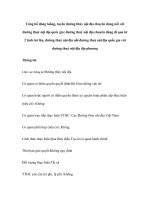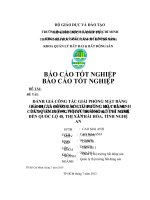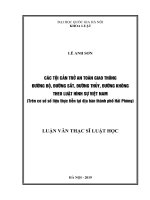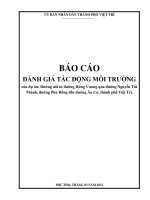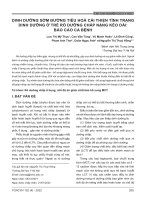Kỹ năng giaot iếp cho điều dưỡng
Bạn đang xem bản rút gọn của tài liệu. Xem và tải ngay bản đầy đủ của tài liệu tại đây (7.09 MB, 206 trang )
COMMUNICATION
SKILLS
FOR NURSES
Student
Survival Skills
Series
Survive your nursing course with these essential guides for all student nurses:
Calculation Skills for Nurses
Claire Boyd
9781118448892
Medicine Management Skills for Nurses
Claire Boyd
9781118448854
Clinical Skills for Nurses
Claire Boyd
9781118448779
Care Skills for Nurses
Claire Boyd
9781118657386
Communication Skills for Nurses
Claire Boyd and Janet Dare
9781118767528
Study Skills for Nurses
Claire Boyd
9781118767528
COMMUNICATION
SKILLS
FOR NURSES
Claire Boyd
RGN, Cert Ed
Practice Development Trainer
Janet Dare
Practice Development Teacher, Assessor, IQA
North Bristol NHS Trust
This edition first published 2014
© 2014 by John Wiley & Sons, Ltd
Registered office:
John Wiley & Sons, Ltd, The Atrium, Southern Gate, Chichester, West Sussex, PO19 8SQ, UK
Editorial offices:
9600 Garsington Road, Oxford, OX4 2DQ, UK
The Atrium, Southern Gate, Chichester, West Sussex, PO19 8SQ, UK
111 River Street, Hoboken, NJ 07030-5774, USA
For details of our global editorial offices, for customer services and for information about how to apply for permission to reuse the
copyright material in this book please see our website at www.wiley.com/wiley-blackwell
The right of the author to be identified as the author of this work has been asserted in accordance with the UK Copyright,
Designs and Patents Act 1988.
All rights reserved. No part of this publication may be reproduced, stored in a retrieval system, or transmitted, in any form or by
any means, electronic, mechanical, photocopying, recording or otherwise, except as permitted by the UK Copyright, Designs
and Patents Act 1988, without the prior permission of the publisher.
Designations used by companies to distinguish their products are often claimed as trademarks. All brand names and product
names used in this book are trade names, service marks, trademarks or registered trademarks of their respective owners.
The publisher is not associated with any product or vendor mentioned in this book. It is sold on the understanding that the
publisher is not engaged in rendering professional services. If professional advice or other expert assistance is required, the
services of a competent professional should be sought.
The contents of this work are intended to further general scientific research, understanding, and discussion only and are not
intended and should not be relied upon as recommending or promoting a specific method, diagnosis, or treatment by health
science practitioners for any particular patient. The publisher and the author make no representations or warranties with
respect to the accuracy or completeness of the contents of this work and specifically disclaim all warranties, including without
limitation any implied warranties of fitness for a particular purpose. In view of ongoing research, equipment modifications,
changes in governmental regulations, and the constant flow of information relating to the use of medicines, equipment, and
devices, the reader is urged to review and evaluate the information provided in the package insert or instructions for each
medicine, equipment, or device for, among other things, any changes in the instructions or indication of usage and for added
warnings and precautions. Readers should consult with a specialist where appropriate. The fact that an organization or Website
is referred to in this work as a citation and/or a potential source of further information does not mean that the author or the
publisher endorses the information the organization or Website may provide or recommendations it may make. Further, readers
should be aware that Internet Websites listed in this work may have changed or disappeared between when this work was
written and when it is read. No warranty may be created or extended by any promotional statements for this work. Neither the
publisher nor the author shall be liable for any damages arising herefrom.
Library of Congress Cataloging-in-Publication Data
Boyd, Claire, author
Communication skills for nurses / Claire Boyd, Janet Dare.
1 online resource.
Includes bibliographical references and index.
Description based on print version record and CIP data provided by publisher; resource not viewed.
ISBN 978-1-118-76750-4 (ePub) – ISBN 978-1-118-76751-1 (Adobe PDF) – ISBN 978-1-118-76752-8 (pbk.)
I. Dare, Janet, author. II. Title.
[DNLM: 1. Nurse-Patient Relations. 2. Communication. 3. Nursing Assessment. WY 88]
RT23
610.7301′4–dc23
2014023322
A catalogue record for this book is available from the British Library.
Wiley also publishes its books in a variety of electronic formats. Some content that appears in print may not be available in
electronic books.
Cover image courtesy of Visual Philosophy
Chapter opener image: © iStockphoto.com/Squaredpixels
Cover design by Visual Philosophy
Set in 9/12pt Trade Gothic LT Std by Aptara Inc., New Delhi, India
1
2014
Contents
PREFACE
vii
INTRODUCTION
ix
ACKNOWLEDGEMENTS
xiii
1
MODELS OF COMMUNICATION
by Claire Boyd and Janet Dare
1
2
TRANSACTIONAL ANALYSIS
by Claire Boyd and Janet Dare
9
3
METHODS OF COMMUNICATION
by Claire Boyd
19
4
PRESENTING YOURSELF AND YOUR ORGANISATION
by Janet Dare, edited by Claire Boyd
41
5
INTERPERSONAL SKILLS
by Janet Dare, edited by Claire Boyd
47
6
TEAM WORK AND THE MULTIDISCIPLINARY TEAM
by Janet Dare, edited by Claire Boyd
55
7
COMMUNICATION BARRIERS
by Janet Dare, edited by Claire Boyd
61
8
ACTIVE LISTENING
by Claire Boyd
71
9
ADMITTING PATIENTS
by Claire Boyd
81
10
SITUATION, BACKGROUND, ASSESSMENT, RESPONSE (SBAR)
by Claire Boyd
105
CONTENTS
11
DOCUMENTATION
by Claire Boyd
119
12
MANAGING CRITICISM AND COMPLIMENTS
by Claire Boyd
143
13
COMMUNICATION SCENARIOS
by Janet Dare, edited by Claire Boyd
159
14
CARE AND COMPASSION IN NURSING
by Claire Boyd
165
ANSWERS TO ACTIVITIES AND TEST YOUR KNOWLEDGE
175
INDEX
187
APPENDICES (SEE END OF CHAPTERS LISTED)
APPENDIX 1 HOSPITAL ADMISSION DOCUMENTATION (SEE CHAPTER 9)
93
APPENDIX 2 THE BRISTOL OBSERVATION CHART (SEE CHAPTER 10)
115
APPENDIX 3 OBSERVATION INFORMATION SHEET (SEE CHAPTER 10)
116
APPENDIX 4A AN SBAR PROMPT SHEET (SEE CHAPTER 10)
117
APPENDIX 4B THE SBAR COMMUNICATION TOOL IN POSTER FORMAT
(SEE CHAPTER 10)
118
APPENDIX 5 CATHETERISATION CARE PLAN DOCUMENTATION
(SEE CHAPTER 11)
126
APPENDIX 6 INTENTIONAL ROUNDING CHECKLIST TOOL FOR FALLS
(SEE CHAPTER 11)
APPENDIX 7 FALLS RISK ASSESSMENT TOOL (SEE CHAPTER 11)
128
130
APPENDIX 8 ADULT PATIENT BEDRAIL RISK ASSESSMENT
(SEE CHAPTER 11)
131
APPENDIX 9 DAILY PRESSURE ULCER RISK ASSESSMENT TOOL
(SEE CHAPTER 11)
132
APPENDIX 10 REVISED VTE RISK ASSESSMENT AUDIT GUIDE
(SEE CHAPTER 11)
vi
136
Preface
This book is designed to assist the student healthcare worker in the skill of
communication, a fundamental component of effective nursing care. It is designed
to give a quick, snappy overview of communication theories, skills and techniques.
The book incorporates many exercises to check understanding, and is done in
a simple-to-follow step-by-step approach. Chapters end with quizzes to relate
everything learned to practice. The aim of this book is to start the individual on their
journey of nursing study right up to graduation. It has been compiled by quotes and
tips from student nurses themselves: a book by students for students.
Claire Boyd
Bristol
April 2014
vii
Introduction
Communication can take many forms, such as verbal or written. It is quite simply
the transfer of information among or between people. However, it is not that simple,
as communication, especially in the nursing profession, can be a complicated
process. In nursing practice we often have a great deal of information to give or send
to others, and we need to do this effectively. Successful communication has three
major components:
1
2
3
A sender
A receiver
A message
Whenever we communicate, we should always be aware that there are factors which
could influence how our message may be interpreted. Variables will need to be
considered, such as the following.
1
2
3
4
5
Who we are communicating with, be they children, adult patients, colleagues or
patients with learning disabilities.
The setting in which the communication occurs, such as in hospital, the
maternity ward or in a service user’s own home.
The sender’s and/or receiver’s past experiences.
The sender’s and/or receiver’s personal perceptions (if known).
The timing of the message.
In health care, breakdown in communication may result in devastating results. For
example, important information may not be conveyed, such as treatment plans
or medications. Let’s look at the scenario. You are looking after a patient in a day
case unit who has just undergone a minor surgical procedure. After handover and
looking at this patient’s observations, which have been plotted on an observations
chart, everything looks fine, although the person is a little tachycardiac (their heart
ix
INTRODUCTION
rate is fast). Then the poor patient vomits. It had not been communicated to you
that the patient told the previous nurse that they felt nauseous and had asked for an
anti-emetic. This is an example of a breakdown in communication, which caused a
negative outcome. Quite frankly, this should not have occurred.
It should never be forgotten that we, the carer, are in a very privileged position
caring for our charges – a patient, or in the maternity setting, in the mental health
sector or with children or babies – wherever we work.
I remember from my student nurse training being told that communication is 80%
non-verbal. We need to observe individuals, paying attention to body language,
eye contact, tone of voice and facial expressions. For example, many of you will
be performing pain management observations and you will no doubt come across
individuals who tell you that their pain is ‘OK’ when their body language screams
that they are in severe pain. Of course, it is a patient’s right to refuse analgesia but
often these patients will tell you later that they did not want to disturb the nurses,
seeing how busy everybody was, and they did not want to be a nuisance.
Much has been written of late, and with good reason, about the lack of care and
compassion in nursing. We need to put the human faith back into the profession.
Show the patient that we do care, that we are listening.
It is every patient’s right to complain, and they should, as we need to know where we
are going wrong. Don’t lose heart as there are many wonderful examples of nurses
and midwives doing a sterling job, often in difficult circumstances. And they often go
well beyond the normal course of duty. Always strive to be the best that you can and
remember why you came into this caring profession.
Janet Dare and I have put together this communications book, giving you, the carer,
a quick, easy-to-read book to help you during your training as a student nurse (and
beyond), assistant practitioner or healthcare assistant, covering many aspects of
the skill of communication. Student nurses have helped us with this book: telling us
what they wanted to be included.
We have looked at nursing aspects of communication from the different sectors of
nursing, covering those caring for adults, children and maternity. Throughout the
chapters we have incorporated actvities to reinforce your learning. At the end of
each chapter you will also have Test your Knowledge questions with the answers at
the back of the book.
x
INTRODUCTION
Remember, patients may not always remember our names, but they will remember
how they were treated, and that should be with kindness, care and compassion.
Good caring!
xi
Acknowledgements
As always, first acknowledgements go to the student nurses who have helped to
make this book possible. As with the other books within the Student Survival Skills
series, it is their tips and quotes that have been used throughout the book.
Thanks also go to Janet Dare (Practice Development Teacher/Assessor/IQA) for her
assistance with putting this book together.
Thank you to Jane Hadfield (Head of Learning and Development) and to all my
friends and colleagues in Staff Development Department at North Bristol NHS
Trust. Thanks also to Magenta Styles (Executive Editor at Wiley Blackwell) for first
approaching me in this exciting project and to all my friends at Wiley Blackwell,
including Nik Prowse (freelance copy-editor) for copy-editing the manuscript and
to Mirjana Misina (Project Manager), Madeleine Hurd (Associate Commissioning
Editor), Catriona Cooper (Project Editor) and James Schultz (Project Editor). Also
a big ‘thank you’ to Simon Boyd for indexing all the books in the Student Survival
series for me.
Thanks also go to the Parliamentary and Health Service Ombudsman for permission
to use information from the document Listening and Learning – the Ombudsman’s
Review of Complaint Handling by the NHS in England 2009–10, and also to the
National Blood Transfusion Committee for permission to use the front cover of the
booklet Amazing You – Let’s Learn About Blood with Billy Blood Drop.
Lastly, thanks to my family for all their assistance, especially Rob for the
photographs and graphs, Simon for the indexing and to David and Louise.
xiii
Chapter 1
.....................
MODELS OF
COMMUNICATION
Communication Skills for Nurses, First Edition. Claire Boyd and Janet Dare
© 2014 John Wiley & Sons, Ltd. Published 2014 by John Wiley & Sons Ltd.
CHAPTER 1
LEARNING OUTCOMES
This chapter will explore communication models that are
used frequently as part of a nurse’s role.
WHAT IS A COMMUNICATION
MODEL?
A communication model is chiefly a process in which
information is channelled, then imparted by the sender to
the receiver through a medium. When the receiver gets the
information they decode the message and may give the
sender feedback.
Theorists have analysed the communication process many
times and how individuals interact with each other. There are
different models of communication that are relevant to a nurse.
These are the linear, interactive and transactional models.
Linear Model
The best-known model of communication is the one
devised by Shannon and Weaver (1949) and was originally
known as ‘a mathematical model of communication’. It is a
simple linear model that is easily understood.
Linear
Arranged in or extending along a straight or nearly
straight line or in one direction.
Linear communication consists of a sender creating a
message. They send it to the receiver without any feedback.
See Figure 1.1.
This model has five main parts:
•
•
2
information source: where the message is produced,
transmitter: where the message is encoded (relayed),
MODELS OF COMMUNICATION
Figure 1.1 A linear model of communication. Adapted from: Shannon and Weaver
(1949).
•
•
•
channel: the carrier of the signal,
receiver: where the message is decoded,
destination: where the message ends up.
What this model is suggesting is that during a
conversation between two people, at any one time only
one person is expressing and sending the information,
and the second person is only receiving and absorbing
the information. When the information is received and
decoded the roles may be reversed, and the second
person becomes the sender and the first person the
receiver. An example of linear communication is a letter
or an email.
One of the advantages of Shannon and Weaver’s model is
that it is simple and easily understood, and can be applied
to most types of communication. However, this type of
model has been challenged because it does not take
into account simultaneous interaction and transactional
feedback. An example of this could be when we try to
communicate with people from different cultures; in such
cases, the message is relayed by one or more of our five
senses (sight, touch, hearing, taste or smell). We observe
the listener’s body language and if they have not heard our
message or it has been misinterpreted then we are able
to adapt our communication or adjust our tone of voice to
accommodate the listener.
Communication relies on the active participation of both
sender and receiver, and cannot be accurately represented
by a linear system.
3
CHAPTER 1
Interactive Model
Wilbur Schramm was one of the early theorists to
demonstrate a circular model of communication. He
proposed that both the sender and receiver interpret the
message, rather than assessing the message’s meaning
(see Figure 1.2).
Schramm (1955; cited in Wood 2009) saw
communication as a two-way process with both the
speaker and the listener providing and receiving verbal or
non-verbal feedback. Both the speaker and the listener
take turns to speak and listen to each other. Other
characteristics of messages that impact communication
between two individuals are intonation and pitch
patterns, accents, facial expressions, quality of voice
and gestures. This model also indicates that the speaker
and listener communicate better if they have had the
same experiences. However, this may mean that both
the receiver and sender are limited by their experience.
Figure 1.2 An interactive model of communication. Adapted from: Schramm
(1954).
4
MODELS OF COMMUNICATION
Nevertheless, there must be some experience common
to both in order for the communication to be useful and
for the intended message to be conveyed. For example,
if you were asking someone who did not speak the same
language as you if they wanted sugar in their coffee,
you would most probably point to the sugar and then
the cup of coffee, hoping that the other individual has
had some common experience of putting sugar in their
coffee. However, if the receiver comes from a culture
where sugar is not used, then your communication will be
ineffective.
Two people from completely different cultures who speak
different languages and who have no common experiences
may find that communication becomes nearly impossible
without help from a third party such as a translator or an
interpreter.
Common ground or mutual understanding is important
in communication and essential for interpersonal
communication.
Transactional Model
The transactional model builds on the interactive model
by adding non-verbal communication methods such as
gestures, eye contact, use of silence, positioning, facial
expressions and body language. It demonstrates that
communication is an ongoing and continuously changing
process. You are changing, the people with whom you
are communicating are changing and your environment
is also continually changing as well. Each person in the
communication process reacts depending on factors such
as their background, prior experiences, attitudes, cultural
beliefs and self-esteem.
Figure 1.3 shows a transactional model of communication
that takes into account ‘noise’ or interference in
communication as well as the time factor.
As you can see from the diagram, the outer lines of the
model indicate that communication happens within a
shared field of experience. This could be that you have
5
CHAPTER 1
Figure 1.3 A transactional model of communication. Adapted from: Wood (2009).
worked in the same department or that you know the same
person.
The transactional model displays communication
interactions as ongoing negotiations of meaning. As already
mentioned, non-verbal expressions take on additional
importance when you are communicating with people from
completely different cultures, speaking different languages
and with no common experiences with which to take part in
this negotiation of meaning.
Individuals come to a communication interaction with their
own field of experience. This includes things like personal
culture, history, gender, social influences and experience.
Your field of experience is the frame of reference that
you bring to each situation that you encounter. At times,
individuals’ fields of experiences overlap and they share
things in common.
Other times, individuals’ fields of experiences do not
overlap; and because they share no common past
experiences, it is difficult to negotiate meaning.
6
MODELS OF COMMUNICATION
TEST YOUR KNOWLEDGE
1
2
3
What is a communication model?
What type of model was identified by Shannon and
Weaver (1949)?
The transactional model builds on the interactive
model by adding what into the communication?
KEY POINTS
•
•
•
•
Defining models of communication
Linear model of communication
Interactive model of communication
Transactional model of communication
Bibliography
Kraszewski, S. and McEwan, A. (2010) Communication Skills for Adult Nurses.
Open University Press, Maidenhead.
McCabe, C. and Timmins, F. (2006) Communication Skills for Nursing Practice.
Palgrave MacMillan, Basingstoke.
Schramm, W. (1954) How communication works. In The Process and Effects of
Communication, Schramm, W. (ed.), pp. 3–26. University of Illinois Press,
Urbana, IL.
Shannon, C.E. and Weaver, W. (1949) A Mathematical Model of Communication.
University of Illinois Press, Urbana, IL.
Sully, P. and Dallas, J. (2010) Essential Communication Skills for Nursing and
Midwifery. Elsevier Mosby, Oxford.
Webb, L. (2011) Nursing: Communication Skills in Practice. Oxford University Press,
Oxford.
Wood, J.T. (2009) Communication in our Lives (4th edn). Thomson-Wadsworth,
Belmont, CA.
7
Chapter 2
.....................
TRANSACTIONAL
ANALYSIS
Communication Skills for Nurses, First Edition. Claire Boyd and Janet Dare
© 2014 John Wiley & Sons, Ltd. Published 2014 by John Wiley & Sons Ltd.


